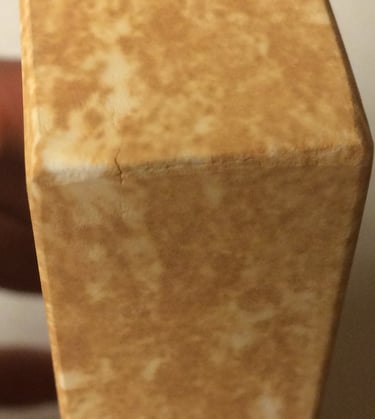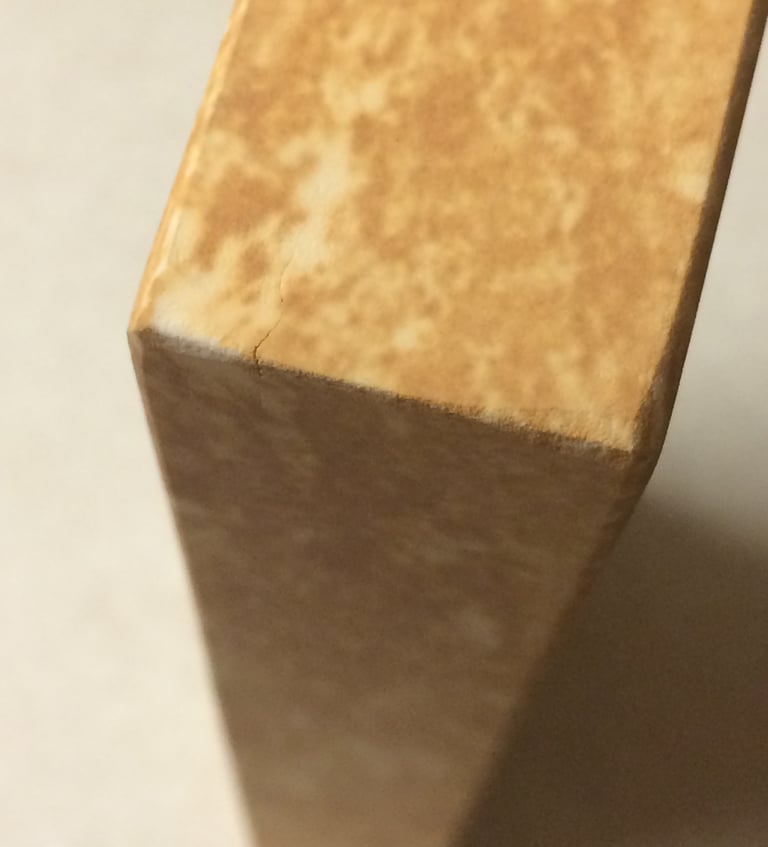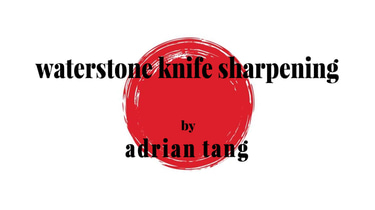Imanishi #400 "Latte"
My initial impression after a few knives
REVIEWS
Welcome to my first stone review on the site. I would like to begin with a preface about my perception of synthetic waterstones in general. First off, I do indeed have my preference of water stone brands as some have characteristics that allow them to work well with a wide variety of steels while other brands may mesh better with some steels and not so much with others. There are as many results from stones as there are sharpeners; creating a subjective opinion of one particular stone which may or may not translate into a useful review/recommendation for another user. The primary values I usually look for are: sharpening speed (how quickly a stone of its rated grit removes metal), and ability to create an aesthetic contrast on clad knives. While I feel these are important, they are not necessarily factors that give a stone a "pass / fail" in regards to quality or value. An example might be some stones may cut more slowly but give a more consistent or shallow scratch pattern allowing larger jumps in grits, achieving a final polish sooner which in turn, may ultimately speed up the sharpening and polishing process. When the multitude of factors [sometimes] align correctly, a very favorable result can occur. Quite simply, what works well for one, may not work so well for another. A negative review is important feedback but this is no reason to completely disregard a stone before trying it for a while and develop your own personal opinion.
This Review of the Imanishi Latte stone has been one of long overdue anticipation. I have been using an Ohishi 600 grit as a final shaping stone to remove coarse scratches from my Nubatama 150 stone. The Ohishi has been a great stone and has served its role well enough in its duties of refinement and blending. And in all reality, I would purchase the Ohishi 600 again as its a very forgiving stone that is fairly soft and fast enough to fill its role in the medium-coarse progression. I would like to add that the Ohishi is a fantastic stone to work single bevels! OK, enough of the Ohishi; this is a Imanaishi review... As the years ticked by, The Ohishi is near retirement and from what I've gathered from other users' feedback, the Latte 400 could be a worthy candidate for replacing my 600 with some added benefits of speed and aesthetic flair. I've wanted to try the Latte 400 since its unveiling in the Chefs Knives To Go inventory. I also wanted to note that this review is for the IMANISHI #400WZ Marble as I understand that the #400WZ also comes in an all white version as well. I presume that they are the same grade, the difference being color tone in appearance only. Please feel free to email me if this is inaccurate. Finally the time has come, so here we go!
Initial out of the box impressions are that this stone is well constructed. It has a hearty heft to it leading me to assume that it has a decent abrasive density and from what I have gathered, spec. sheets indicate that this stone is a ceramic abrasive. The Latte definitely benefits from a long 20+ minute soak before starting. This stone needed moderate lapping before use and as always, chamfer the surface edges. Oddly, there were some voids that were visually apparent but I am not concerned about it as the stone is still functional and structurally sound. Thankfully only one side had imperfections so I'll just flip the stone over so the hole is on the bottom. Here's some photos below:








My first knives on this stone were softer stainless (58+hrc) and they were a breeze to correct. Very predictable experience with a moderate amount of mud being produced. The Latte is porous and will let water through even after a slurry is raised with nagura. The redeeming side is that after some swarf (metal particles) are worked into the slurry, the stone does slow down on the water consumption which allows me to just focus on sharpening without tending to watering the stone as often. I had some other knives needing some work and took the opportunity to try some semi-stainless steel (carbo-next) on it followed by Blue #2, White #2 & #1, and finally a Super Blue chef knife (which is shown here in my first take).
NOTE: (Please bear in mind that these particular sharpening videos are NOT Demonstration or How-To videos. These Latte #400 videos are of me working a kit for a client. Normally everything would be different as far as choice of coarse stone, stone progression, and total time spent working toward the sharpening requirements for these pieces. The tasks performed here are above what I feel would be the "normal" spectrum of work by ANY #400 stone and what we captured here is the Latte #400 being pushed to its boundaries.)
This Super Blue was a great flavor to benchmark the aggressiveness of the stone and taking note of the feedback from a harder steel. There is definitely a "skating" sensation that is present (more so than lower HRC steels) when sharpening the harder Super Blue formula. This stone cannot compare to diamond plates; other comparable stones in my lineup also have similar results and feel with this particular Super Blue gyuto. Ultimately, any synthetic waterstone would likely have the similar feedback with any steel reaching into 65HRC territory. This perception is not intended to downplay the Latte and write it off as just another #400 stone, rather it is a very capable stone that effectively removes metal at a fast enough pace given the amount of wear incurred, that it falls well within the range of a moderate/high value purchase.
The next knife used for video demonstration is a Yoshihiro 210mm Tsuchime Damascus VG-10 Gyuto. I believe this knife is tempered down to ~60HRC and is very much at home on this #400 ceramic with an extremely familiar and ductile thinning session providing exceptional feedback while the softness of the Latte forgives a moderate range of error in both contact angle and sharpening pressure. This was a very fun and enjoyable session with this stainless gyuto. No surprises, easy to work, and takes the abuse of a hurried and urgent pace to the finish line. Again, this thinning session was another attempt to push the Latte beyond its capability, and it didn't flinch. I really loved the feel of sharpening AND thinning on the Latte with a fresh raised slurry from a diamond plate. Even after the roughed-up surface was smoothed out to its native grit, the mud assures a nice clean connection of knife to stone as sharpening and [some] polishing takes place; maintaining its strong characteristic of sharpening speed. In my opinion, a faster stone takes less passes to remove an equivalent amount of metal as a slower stone thus creating an opportunity for not only a shorter, more productive session, but a more precise result by omitting the need for excessive passes on the stone which increases the chances for error. Less strokes = less chances for mistakes.
Mitsumi Part 1
Mitsumi Part 2
I'm so glad to have chosen this stone. It has a very important role in my lineup and will be one of the more heavily used stones for sessions with refining scratch patterns and maintaining edge geometry. I am welcoming the relief the Nubatama #350 Platinum will see.
Thanks for your time.
